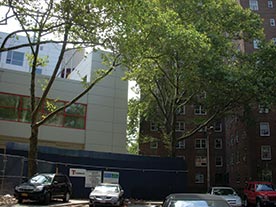Harlem Children’s Zone’s new Promise Academy, abutting one of the buildings in the St. Nicholas Houses. Photo by Alexis Stephens
“Mind you, they are taking someone’s public space—what little space they have—and putting in garbage compactors.”
That’s how one organizer I spoke with for my article “The Case of NYCHA’s Disappearing Open Space” published in Shelterforce, described the situation at one Harlem public housing development where a charter school is being built on the campus.
In that article, I examined the construction of two such charter schools, which appear to be early iterations of a long-term plan by the New York City Housing Authority to lease out what it calls its “vacant” and “under-utilized” land to earn revenue.
Both projects rise within the borders of public housing campuses in Harlem, and each eliminates space that previously served residents through open air, sunlight, trees, walking paths, recreation, and sites to gather. In both cases, there were residents and community organizations who felt alienated from the planning process for the schools and had objections to the location and scale of the projects.
Since I wrote that article, NYCHA’s plan to lease out this land has ramped up and taken an even more provocative turn.
In early February, the New York Daily News broke the story that NYCHA has plans to lease land—3 million square feet—from public housing developments in the prime real estate neighborhoods of the Upper East and West sides, lower Manhattan, and the Lower East Side for the private development of luxury housing.
Open space is only one of the many concerns coming up about this plan. There are strong reservations about NYCHA’s commitment to responding to public input during the planning process. Also, NYCHA Chair John Rhea’s justification for the need to pursue this project is based on what he has framed as a fiscal crisis, while there are widespread reports that NYCHA is sitting on as much as $955 million of federal funds while there is a current maintenance backlog of 350,000 open repair orders for 400,000 residents.
Another issue is that the amount of affordable units proposed in the new developments is only 20 percent, and yet would give tax incentives to developers. Some community leaders want to negotiate with NYCHA for a higher provision.
The Open Space Angle
What are the social and ecological impacts of the construction of these mammoth structures for New York’s wealthy on public housing campuses? In the charter school cases, the perceived tradeoff between education and the loss of health and community benefits put residents who wanted to contest the developments at a strong disadvantage as schools are also needed in those communities. With these new plans for luxury condos, however, NYCHA will have a much harder time justifying the benefits to residents.
The most publicized recent plan is at the Smith Houses, where a development is envisioned on top of a parking lot and a baseball diamond. This is a loss of active recreation space for residents and would result in an increase in density and population. Where will the amenities for a new population with new needs have to be located? Where will replacement parking need be constructed? Will community recreation facilities still be considered a valuable allocation of space in NYCHA developments?
Further, are there reasons for public housing residents to trust that additional NYCHA revenue will result in the improvement in maintenance response? Will these improvements be worth the loss in quality of life in their communities?
Not Overreacting
This week’s New York Times article on the proposed plan says that it “has stirred deep concern, if not paranoia, among tenants who have been warily eyeing gentrification in one of the nation’s most expensive housing markets.” Characterizing public housing residents as paranoid undervalues their concerns, is frankly classist (at the least), and could be argued to be myopic considering that tenants have ample reasons to be wary about being told from on high what will ultimately benefit “them.”
History backs them up: We are just a few generations away from slum clearance programs that uprooted families in the 1940s for these “towers in the park” to be built in the first place. We are fewer generations still from the white flight and urban disinvestment that contributed to New York’s fiscal crisis in the 1960s and 1970s. And we are living with memory of the rapid gentrification of the 1990s, which has only advanced more intensely in the Bloomberg administration, challenging low- or moderate-income households to be able to afford to ever make the transition out of public housing. Not to mention the smaller, local battles that these communities have faced over time and the daily battles that families wage over repairs.
These developments, if built as intended, will permanently disrupt both the ecologies and the sense of place in these communities. And their residents know it.





Comments